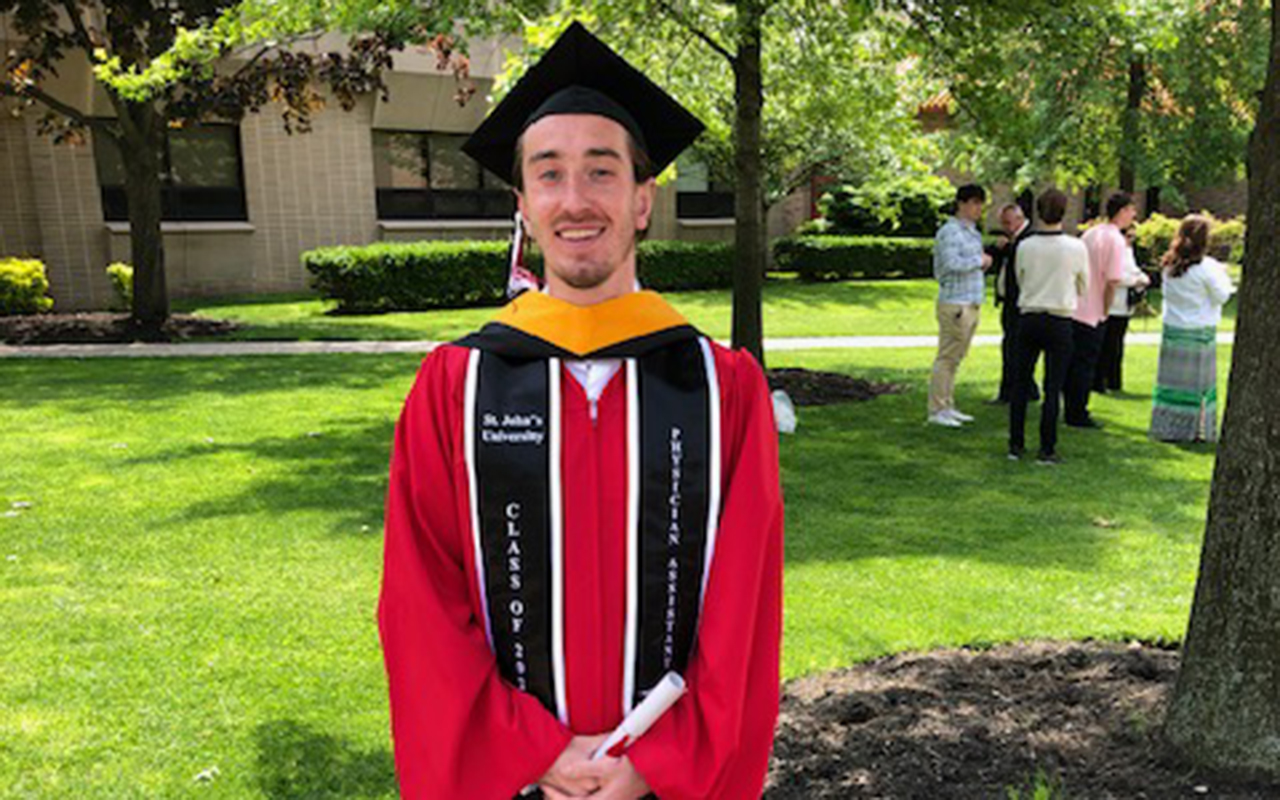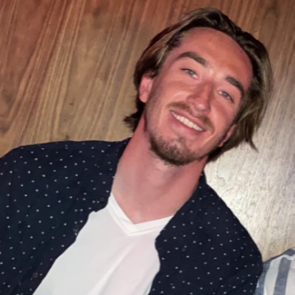From tragedy to triumph, and the 30 surgeries along the way
After a devastating accident, Shane Dennehy ’19 achieves his dream of becoming a physician assistant

Shane Dennehy has told this story a thousand times, but he reserves the full version for friends and colleagues in the medical field. You’ll soon understand why: The interviewer — the person behind this byline — fainted twice during the 40 minutes it took to tell it.
“Maybe you weren’t the right person for this assignment,” he said with a good-natured smile. “This is kind of gory.”
A newly minted physician assistant (PA), Dennehy has a deep appreciation for the intricate twists and turns of a medical case. The Long Island native knew he wanted a career in the field since high school. In March 2019, the year he was set to graduate with a degree in integrative neuroscience, he was looking forward to his next step — after some spring break fun. It was, after all, his senior year.
He joined the University’s Greek life on a trip to Punta Cana in the Dominican Republic. Sun, blue sky, blue water, friends — all perfect ingredients for a Caribbean cruise.
“They packed everyone on these little boats. We were having a great time, and then it was a wrong place, wrong time type of situation,” he remembered.
His boat featured a slide. The first unfortunate decision of the day: He went down the slide; he knows that much, but then his memory stops. Somehow that led to his second unfortunate choice: He swam to the end of the slide and held onto the edge of the boat.
He didn’t realize he was right next to the boat’s outboard motors. Then, someone turned the ignition.
The propellers began to spin.
(If you’re squeamish, you may want to skip to the final section of this story.)
Boat motors aren’t kind to the human body. The blades tore into Dennehy’s left leg, flaying him to the bone and spraying blood in the water. He doesn’t remember this part, and learned later just how lucky he was in his misfortune: just 5 millimeters in one direction, and he would have lost his leg. A slight distance in another, and he would have bled out before he reached the shore.
Good luck and the bad
He was lucky in other ways, too: His friends from Binghamton happened to be medics, trained on Harpur’s Ferry.
“They just sprung into gear. They jumped into the water and got me off the propeller; they had to use a wrench to pull the propeller off the boat and out of my leg,” he said. “They had blankets, towels and everything, and they put a tourniquet on my leg.”
A newly married couple had been traveling past in a speedboat and stopped to supply a First Aid kit. Another speedboat was called in to bring Dennehy to shore with four of his friends; reaching land, they grabbed a gurney from a lifeguard stand and ran a mile down the beach, looking for the road.
They flagged down a random van, which took them to the small local hospital. From there, an ambulance sped Dennehy inland to the island’s best hospital, and a friend contacted Dennehy’s parents back home in Long Island.
At his parents’ insistence, Dennehy was stabilized for transport back to New York City via a medical charter flight. Another lucky break: Dennehy had paid for travel insurance when he booked the trip.
“If you didn’t want the insurance, you would have to send them a written letter. I’m a college student; I wasn’t about to write a letter and figured I would just pay the $75,” he remembered. “That $75 paid for a $30,000 medical flight.”
Back home, his parents frantically made arrangements to have him admitted to a top New York City hospital. Then, some bad luck: The first flight fell through, and Dennehy spent the night and the next day in the hospital. If he couldn’t reach the mainland in the next 48 hours, the island doctors would have to operate. Barely conscious, Dennehy remembered snippets of what came next: being carried by stretcher from an ambulance on the tarmac, directly into the tiniest airplane he had ever seen. His leg ached.
“Can you guys give me anything?” he asked as the medic squeezed in behind him. “I want to go to sleep and not be awake.”
“Don’t worry,” the medic replied. “This plane goes to higher than normal altitudes. As we hit altitude, you’re going to pass out.”
Shortly after takeoff, Dennehy was out cold. The plane stopped to refuel in Florida and North Carolina before landing in New Jersey, where Dennehy was loaded onto yet another ambulance — this time headed straight to surgery. Or, rather, the first of 30 surgeries.
Dennehy’s condition ultimately required multiple doctors; his plastic surgery and reconstruction team came from New York-Presbyterian/Weill Cornell Medical Center, while his orthopedic team came from the affiliated Hospital for Special Surgery next door.
His wound was dirty, and the initial surgeries — conducted every Monday, Wednesday and Friday for the first few weeks — cleaned out infection and dead tissue. Surgeons weren’t sure initially they could save his leg, although — luck again — Dennehy could wiggle his toes, which meant that the propeller missed his sciatic nerve. Eventually, the surgeon hit tissue that bled — a sign that the muscle was still alive.
Dennehy’s hip was set with a rod, plate and screws. Due of the lack of skin and tissue, the wound couldn’t be immediately closed; the next few surgeries consisted of placing artificial skin made from shark and cow skin, followed by skin grafting.
When conscious, he completed class assignments remotely — an unusual arrangement in the days before the pandemic. He was determined to graduate on time, and to walk at Commencement alongside the friends who saved his life.
“Just five days after the accident, Shane’s mother contacted me to figure out how Shane could complete his degree. I couldn’t believe that he could focus on schoolwork with all of the surgeries his mother described in his future but she was adamant that Shane wanted to try,” remembered Harpur College Assistant Dean for Academic Affairs and Advising Kathy Brunt. “With incredible determination, he completed his degree.”
Dennehy hit physical therapy hard, with a pair of three-hour sessions every day. The fasting from his frequent surgeries starved him down to 117 pounds on his 6 foot 2 frame, and he hadn’t walked a step since Punta Cana. Two days before he was scheduled to be discharged from the hospital, he felt fluid run down his leg: The infection had returned.
The prospect of Commencement faded as Dennehy underwent more surgeries. One lasted 12 hours and transferred healthy muscle from his right leg into his left.
“I had the greatest plastic surgeon and the best orthopedic team in the world working on me,” he said.
Ten days later, he was able to head home for the first time in three months, still hooked up to intravenous antibiotics. Although the wounds healed, sitting hurt — leading to his next two surgeries for tissue expansion and rehab as he applied for PA school.
“I actually did my interview at St. John’s (University) with the balloons in my leg,” he said, referring to the saline implants that expanded his skin. “I was able to walk without crutches. They asked about my limp, so I told them about my situation.”
Back to the hospital, on the other side
The surgeries and rehabilitation took up Dennehy’s gap year before he started at St. John’s in September 2020; he graduated in the summer of 2023. Today, he walks without a limp, although his leg features a massive Y-shaped scar.
“If you saw me walking around and you didn’t know my story, you would have no idea what I’ve been through,” he said.
In a way, Dennehy has come full circle: He landed a job at the Hospital for Special Surgery — on the same orthopedic team that gave him his life back after that devastating turn of events. He had become close with his doctors during his ordeal and, during his training as a physician assistant, was able to arrange clinical rotations at both hospitals with the teams that worked on him.
Through all the suffering of that long year, Shane is deeply grateful for all the lucky breaks — including the decision to buy travel insurance. Instead of a wheelchair or prosthesis, he can still shoot hoops and snowboard, feats that would be unimaginable during those early hospital days.
He is also deeply grateful for all the medical personnel who treated him, the understanding faculty and staff at Binghamton who allowed him to graduate on time — and especially his friends. One is currently in medical school, another became a physician assistant like Dennehy, and the third a police officer; the fourth went into biomedical engineering.
“They got me to the shore and the hospital. They kept me alive,” he said. “The fact that I had friends who were willing to jump in the water and get bloody to take care of me was a godsend.”


